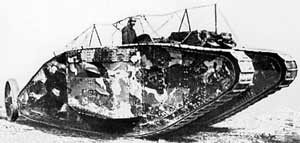Armoured Vehicle Museum >>
|
|||||||||||||||
The British Mark I was the world's first tank, entering service in World War I, born of the need to break the domination of trenches and machine guns over the battlefields of the Western Front. Along with subsequent variants, it was the most successful heavy tank of the war. Description The Mark I was a rhomboid vehicle with a low centre of gravity and long track length, able to grip muddy ground and cross trenches. Sponsons (also called "barbettes") on the hull sides carried two naval 6-pounder guns. There were two Hotchkiss machine guns in the sponsons and two removable guns for the front and back. The hull was undivided internally; the crew shared the same space as the engine. The environment inside was extremely unpleasant; the atmosphere was contaminated with poisonous carbon monoxide, fuel and oil vapours from the engine and cordite fumes from the weapons as ventilation was inadequate. Temperatures inside could reach 50 °C. Entire crews lost consciousness or became violently sick when again exposed to fresh air. To counter the fumes inside and the danger of bullet splash or fragments and rivets knocked off the inside of the hull, the crew wore goggles and chainmail masks. Gas masks were standard issue as well, as they were to all soldiers at this point in the war (see Chemical warfare). The side armour of 8 mm initially made them largely immune to small arms fire, but could be penetrated by the recently developed armour-piercing K bullets. There was also the danger of being overrun by infantry and attacked with grenades. The next generation had thicker armour, making them nearly immune to the K bullets. In response, the Germans developed a larger purpose-made anti-tank rifle, and also a Geballte Ladung (‘Bunched Charge’) - several regular stick grenades bundled together for a much bigger explosion. A direct hit on the roof by an artillery or mortar shell could cause the fuel tanks (which were placed high in the front horns of the track frames either side of the drivers' area, to allow gravity feed) to burst open. Incinerated crews were removed by special teams that were forbidden to have any contact with the still living tank crews. Steering was difficult; controlled by varying the speed of the two tracks. Four of the crew, 2 drivers (one of which also acted as commander; he operated the brakes, the other the primary gearbox) and 2 'gearsmen' (one for the secondary gears of each track) were needed to control direction and speed - not that the Mark I was ever able to manage more than a walking pace. As the noise inside was deafening, the driver, after setting the primary gear box, communicated with the gearsmen with hand signals, first getting their attention by hitting the engine block with a heavy spanner. For slight turns, the driver could use the steering tail: an enormous contraption dragged behind the tank consisting of two large wheels, each of which could be blocked by pulling a steel cable causing the whole vehicle to slide in the same direction. If the engine stalled, the gearsmen would use the starting handle - a large crank between the engine and the gearbox. There was no wireless; communication with command posts was by means of two pigeons, which had their own small exit hatch in the sponsons, or by runners who were encouraged to complete their suicidal mission by receiving bottles of strong drink as a reward. Later marks carried semaphore arms for signalling. Production history The Mark I was a development of Little Willie, the experimental tank built for the Landships Committee by Lieutenant Walter Wilson and William Tritton in the summer of 1915. Working on problems discovered with Willie, the Mark I was designed by Wilson. A gun turret above the hull would have made the centre of gravity too high, so the guns were put in sponsons. The prototype Mark I, ready in December 1915, was called "Mother". 150 were built. See history of the tank for a fuller story. Variants A requirement was found for two types of armament, so Mark Is were armed either with 6 pounder guns and four machine guns and called "Male" (75) or two Vickers machine guns instead of the 6 pounders and called "Female" (75). To aid steering, a pair of large wheels were added behind the tank. These were not as effective as hoped and were subsequently dropped. The subsequent Mark II, III, IV and V and later tanks all bear a strong resemblance to their 'Mother'.
Combat Weight
Armament
Combat history
|
|
||||||||||||||




